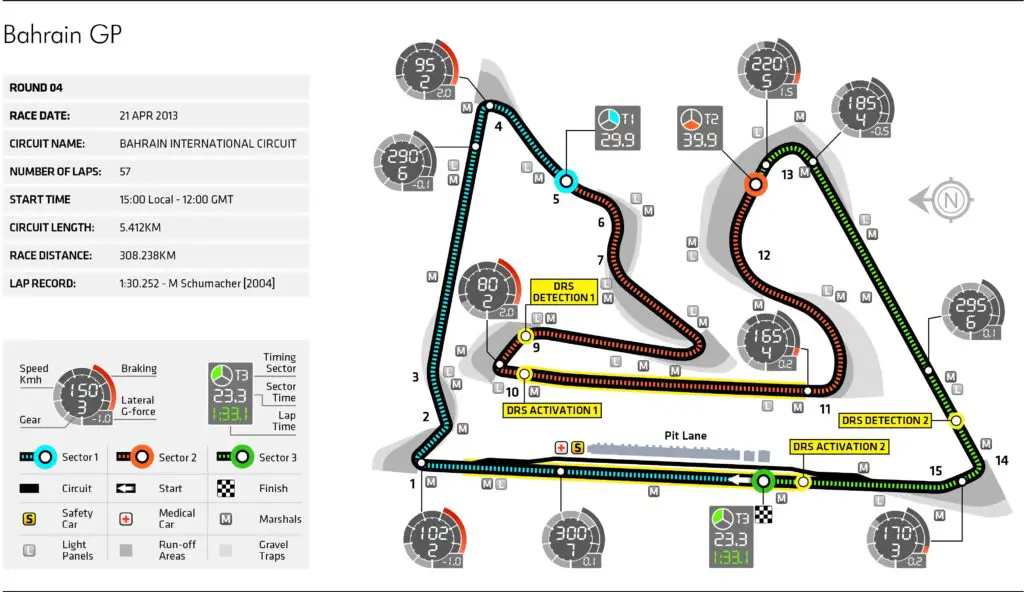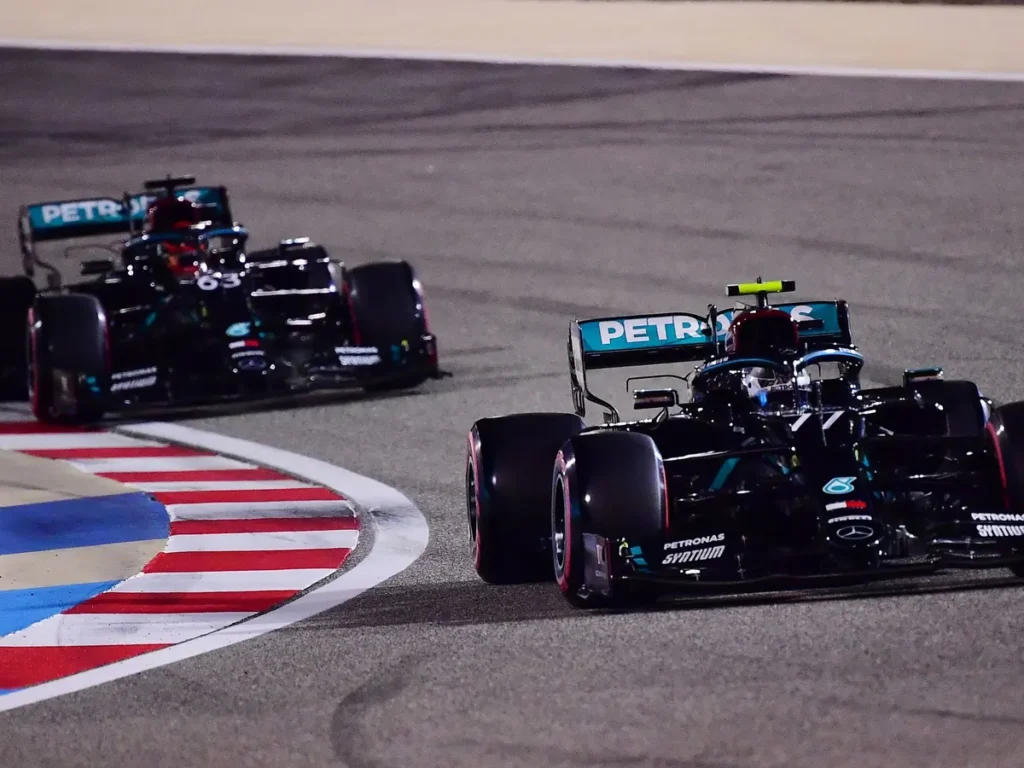The Sakhir GP is a thrilling event in the world of Formula 1, featuring a challenging track that tests the skills and abilities of drivers. In this SEO article, we will provide a detailed corner-by-corner description of the Bahrain International Circuit Layout.
We will discuss the speeds at which each corner is taken, the gear selections made by drivers, the G forces experienced in each corner, and the braking requirements. Additionally, we will delve into the typical temperatures that drivers have to cope with during the Bahrain GP.
Track Layout and Key Features

Turn 1 – “The Hairpin”
Turn 1, known as “The Hairpin,” is the first corner of the Bahrain GP track. Drivers approach this corner at speeds of around 200 km/h (124 mph).
To tackle this sharp right-hand hairpin, drivers need to brake heavily, reducing their speed to approximately 90 km/h (56 mph). Typically, drivers downshift to second gear for optimal control and acceleration as they exit the corner.

The G forces experienced in this corner are moderate, around 2-3 G.
Sakhir GP: Turn 2 – “The Left Hook”
Following The Hairpin, drivers quickly transition into Turn 2, known as “The Left Hook.” Drivers negotiate this medium-speed left-hand turn at speeds of approximately 170 km/h (106 mph).
They try to maintain their momentum through this corner, applying light brake pressure if necessary.
Drivers commonly select second gear enabling good balance and traction for a smooth exit onto the next straight. The G forces experienced here are around 2 G.
Turn 3 – “The Double Right”
Turn 3, referred to as “The Double Right,” presents a complex section of the Bahrain GP track.
Approaching this corner at high speeds, drivers reach approximately 250 km/h (155 mph). To navigate this double right-hand turn, drivers apply heavy braking, reducing their speed to around 130 km/h (81 mph).
Typically, drivers select third gear to maintain stability and grip throughout the corner, accelerating out of it. The G forces experienced in Turn 3 can range from 3-4 G.
Sakhir GP: Turn 4 – “The Long Left”
Turn 4, also known as “The Long Left,” is a sweeping left-hand corner that demands a delicate balance of speed and precision.
Drivers tackle this corner at speeds of around 230 km/h (143 mph) and experience high lateral G forces. As drivers approach this corner, they apply gentle braking to adjust their speed.
Typically, drivers select third gear allowing them to maintain momentum and carry speed through the corner, setting them up for the next straight.
The G forces experienced here can reach up to 4 G.
Sakhir GP: Turn 5 – “The Tricky Chicane”
Turn 5, referred to as “The Tricky Chicane,” is a challenging sequence of left-right turns. Drivers approach this chicane at speeds of approximately 230 km/h (143 mph). It requires heavy braking to slow down to around 120 km/h (75 mph).
Typically, drivers select third allowing them to maintain control as drivers navigate through the chicane, aiming for a quick and smooth exit. Acceleration out of the chicane is vital as it leads directly into the next high-speed section of the track.
The G forces experienced in this chicane can reach up to 3 G.
Sakhir GP: Turn 6 – “The Right-Hander

Turn 6 is a fast right-hand corner that requires precision and control. Drivers approach this corner at speeds around 280 km/h (174 mph).
To navigate this corner effectively, drivers often apply moderate braking, adjusting their speed to approximately 190 km/h (118 mph).
Typically, drivers select fourth gear to optimize traction and stability. Exiting this corner smoothly is crucial to maintain momentum for the following straight.
The G forces experienced in Turn 6 can reach up to 4 G.
Sakhir GP: Turn 7 – “The Sweeper”
Turn 7 is a sweeping left-hand corner that tests drivers’ ability to carry speed through the turn. Drivers enter this corner at speeds of approximately 235 km/h (146 mph).
Drivers brake moderately to control speed, and drivers often downshift to third gear. Balancing the car’s weight distribution is vital to maintain stability and exit the corner swiftly. The G forces experienced in Turn 7 are around 3 G.
Sakhir GP: Turn 8 – “The Right-Hand Bend”
Turn 8 is a challenging right-hand bend that demands precise car control.
Drivers approach this corner at speeds of around 250 km/h (155 mph). Braking is required to reduce speed to approximately 180 km/h (112 mph).
Typically, drivers select third gear to provide optimal grip and control. Exiting Turn 8 smoothly is crucial to set up for the subsequent straight.
The G forces experienced in this corner can reach up to 4 G.
Sakhir GP: Turn 9 – “The Left-Hand Turn”
Turn 9 is a medium-speed left-hand turn that requires a balanced approach. Drivers approach this corner at speeds around 220 km/h (137 mph).
Controlled braking is applied to adjust the speed to approximately 160 km/h (99 mph). Typically, drivers select third gear is to maintain stability and control as drivers exit the corner.
The G forces experienced in Turn 9 range from 2-3 G.
Sakhir GP: Turn 10 – “The Right-Hander”
Turn 10 is a challenging right-hand corner that demands precision and skill. Drivers approach this corner at speeds of approximately 230 km/h (143 mph).
Heavy braking is required to reduce speed to around 140 km/h (87 mph). Typically, drivers select second to maximize traction and acceleration. A smooth exit from Turn 10 is crucial to carry speed into the following straight. The G forces experienced in this corner can reach up to 3 G.
Sakhir GP: Turn 11 – “The Left-Hander”
Turn 11 is a medium-speed left-hand corner that tests drivers’ control and car balance. Drivers approach this corner at speeds of approximately 195 km/h (121 mph).
Moderate braking is applied to adjust the speed to around 140 km/h (87 mph). Typically, drivers select third gear to provide optimal grip and control. Smoothly exiting Turn 11 is crucial to carry speed onto the subsequent straight.
The G forces experienced in this corner range from 2-3 G.
Sakhir GP: Turn 12 – “The Right-Hander”
Turn 12 is a challenging right-hand corner that demands precise car control. Drivers approach this corner at speeds around 195 km/h (121 mph).
Controlled braking is required to reduce speed to approximately 135 km/h (84 mph). Drivers select 3rd gear to maintain stability and control as drivers exit the corner.
Maintaining a good racing line is essential for a swift exit and optimal speed for the following sections.
The G forces experienced in Turn 12 can reach up to 3 G.
Sakhir GP: Turn 13 – “The Left-Hander”
Turn 13 is a high-speed left-hand corner that requires skill and finesse. Drivers enter this corner at speeds of approximately 260 km/h (162 mph).
Controlled braking is applied to adjust the speed to around 210 km/h (130 mph). Drivers select fourth gear for optimal traction and stability. Carrying speed through Turn 13 is crucial for a quick exit onto the following straight.
The G forces experienced in this corner can range from 3-4 G.
Sakhir GP: Turn 14 – “The Right-Hander”
Turn 14 is a fast and technical right-hand corner that demands precision and control. Drivers approach this corner at speeds of around 225 km/h (140 mph).
Decisive braking is required to reduce speed to approximately 150 km/h (93 mph). Third gear is typically selected to optimize traction and acceleration. A smooth exit from Turn 14 is crucial to carry speed onto the subsequent straight.
The G forces experienced in this corner can reach up to 3 G.
Sakhir GP: Turn 15
Turn 15 is the final corner of the Bahrain GP track, leading drivers onto the main straight. Drivers enter this corner at speeds of approximately 190 km/h (118 mph).
Controlled braking is applied to reduce speed to around 135 km/h (84 mph). Third gear is commonly selected to maintain stability and control.
Carrying optimal speed through this corner is crucial for a strong exit onto the main straight and setting up for overtaking opportunities. The G forces experienced in Turn 15 range from 2-3 G.
Temperatures the Drivers Have to Withstand
The Bahrain GP takes place in a desert environment, subjecting drivers to scorching temperatures.
On race days, the typical temperatures in Bahrain can soar well above 35°C (95°F), with the track temperatures even higher due to intense sunlight.
These extreme conditions pose a significant challenge to drivers, both physically and mentally. To cope with the heat, drivers need to stay hydrated throughout the race and maintain their focus despite the oppressive weather.
Adequate physical conditioning and cool suits are essential to combat the intense temperatures and prevent heat-related issues.
Conclusion
The Bahrain GP track is an exciting circuit that demands precision, control, and skill from Formula 1 drivers. Each corner poses its unique challenges, with varying speeds, gear selections, G forces, and braking requirements.
From The Hairpin to The Tricky Chicane, drivers must navigate these corners with finesse to gain a competitive advantage.
The extreme temperatures endured during the race add an extra layer of complexity.
The Bahrain Grand Prix tests the mettle of both drivers and their machines, providing fans with thrilling races and showcasing the drivers’ exceptional abilities to adapt and conquer the challenges presented by the track and the climate.

